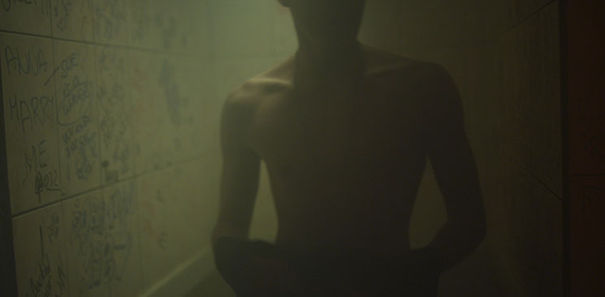The Bridge of Age
Georgiana Madin of the 2013 Talent Press Sarajevo reviews the short film MORNING PRAYERS, directed by Konstantina Kotzamani and Katarina Stanković.

Konstantina Kotzamani's and Katarina Stanković's MORNING PRAYERS.
At the time when the low-pitched murmur of the morning escalates into full-blown bustle, a boy and a girl indecisively wander the streets of Sarajevo in search of tenderness. It doesn't matter that the bluish hues of dawn are a waking sign or a call to Sabah for Muslims; they are there to seize the promises of the passing night. Despite an opening club scene that vividly recalls the nauseating atmosphere of Gaspar Noé's IRREVERSIBLE (2002), the short film directed by Konstantina Kotzamani and Katarina Stanković proves to be not another promiscuous teenage story, but one with an unexpected shift of attention which squeezes its protagonists into an eerie state of solemnity.
The beginning of MORNING PRAYERS cues the viewer into anticipating drug use consequences and even violence, but as soon as the two are kicked out from the club where they first kiss, the constant shift of focus turns from ominous to sensual, from muddy tones to exuberant blues, reds, greens, and violets. Whereas the instability of the focus threatened the grasping of space and time between the tight walls of the club, on the crepuscular streets it enhances the consistency of colors and it erases distances between the boy and the girl. For most of the narrative, the two are involved in a quirky yet awkward and sluggish game of seduction, partly because of fatigue, and the directors are concerned with blurring not only the physical limits that lie between them, but also their surroundings.
Their dialogue is scant and symbolic, centered around water motifs (the colorful dying jellyfish), and their actions are limited to physically teasing each other as he submissively follows her; but as the camera approaches even closer, the hesitant focus no longer seems arbitrary, and becomes a tool which gives each shot a slippery feel. Much as they want to be energetic, they are dizzy, unstable and frail, and, even more successfully than subjective shots, the impressionistic aesthetics (their points of view transmitted by the shaky aim of the camera) illustrate their internal states of imbalance and inaccurate perception of the surroundings. They move on earth as they would do in water, an aspect rendered by the decomposing colors that fade one into the other and the close-ups that deny the viewer the reconstruction of the mise-en-scène.
Still, the watery surfaces of MORNING PRAYERS run deeper than a mere reflection of youthful colours, and within the same stylistic parameters the tone of the film makes another surprising departure once they arrive at what seems to be the girl's apartment. Echoing an earlier line of the boy when he questions the girl's existence, their prelude is interrupted by an episode which carries the allure of a horror film, bearing resemblance with a scene of THE SHINING (1980). Preparing himself for his first time with a woman, the boy finds an old man lying almost unconsciously in the water-filled bathtub and tries to lift him up. His body is too heavy and, though we can't see it, a very short shot of his descending point of view suggests that he dies. At this moment, the boy's susceptibility, his weariness, the slipperiness of reality, the water and the jellyfish motifs all converge into one hallucinatory moment that perforates the texture of sensuality. Suddenly, eroticism withers under death’s weight.
Even though the old man's presence is eventually explained, his presence in the bathtub and his association with the water motif makes for a chilling sensation. Blurriness and lack of vigor (seen both as characters' states, as well as traits of cinematography) no longer indicate debauched youth, but are directly associated with organic decomposition and contamination. The fact that "grandpa" – as the girl calls him – proves not to be her grandpa, but a lonely old man that she regularly checks up on, furthermore lifts the self-assuring veil off their eyes and startlingly reunites with the film's questioning of reality.
The way the filmmakers choose to deal with this radical change is both crushing and redeeming – scant dialogue becomes a way to solemnly evade the reality of death, and blurriness is replaced in the last shots by the sharpness, geometrical lines and utter stillness of the Parrot building and the surrounding blocks of flats. If the shapes were almost amorphous and rhymed with joyousness before, at the end one can feel the stiffness of buildings as a stiffness of death. Everything freezes into a static prayer, there is no more movement, or if there is, it is timorous and trapped behind bars. An incredibly invigorating cinema exercise, MORNING PRAYERS takes its characters and its viewers from the hazy underground of youth pursuits, where time seems infinitely elastic, to the instability of human existence, all the while cunningly playing with the same deck of cards.

